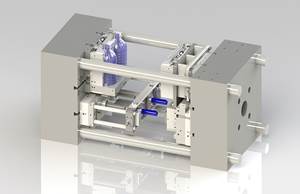How to Size a Machine and Tooling for Industrial Parts
Today’s industrial blow molding machines are highly efficient and predictable and generally can be relied on to produce sophisticated parts from the first shot.
Today’s industrial blow molding machines are highly efficient and predictable and generally can be relied on to produce sophisticated parts from the first shot. But it’s still wise to brush up on some basic guidelines to help you get started with properly sized equipment and tooling, especially if you’re making a particular part for the first time.
First, consider closely the the part characteristics. Will it require flash only on the top and bottom? Or maybe the only way to make good parts will be to flash all the way around? Project the finished weight of the part, and then estimate the shot size, including flash.
Flash only on the top and bottom of the part will mean a complete shot weight about 25% to 40% more than the final trimmed part weight. If the flash is all the way around, this could increase the shot weight by upwards of 60%. I have seen that reach 100% in some parts, so be careful with your estimate.
Shot size and cycle time will also influence the output required of the extruder. Estimate the needed output capacity of the extruder at 80% of its maximum screw speed. And the extruder must be working well to ensure a low melt temperature. The hotter the material, the longer the cycle time.
The finished wall thickness of the part plays an important role in cycle time. If the wall thickness is 0.060 in. or less, the cycle time will be in the area of 40 to 50 sec. A wall thickness of 0.080 to 0.100 in. will result in a cycle of around 60 to 70 sec. Parts with walls of 0.120 to 0.180 in. could result in cycles up to 180 sec. These are only estimated guidelines; depending upon tack-offs, for example, handles and very thick areas of the part will influence the overall cycle.
Another matter to be carefully considered is the size of the accumulator head that your part and process will require. Here are some guidelines:
- Determine necessary head tooling size. You might require larger head capacity than output needs alone would indicate, in order to get the proper head tooling size for the part.
- Find out the parison layflat needed based upon top/bottom or all-around part flash. (Layflat = tooling diam. x 3.14 ÷ 2). This equation does not consider die swell or parison preblow inflation.
- Factor in parison die swell. Normally, larger tooling diameters have smaller parison swell. Small tooling produces a larger percentage of swell.
- Remember that competitive heads may produce different parison sizes for a given tooling size.
- Determine if there is a limit on how much regrind can be put back into the finished part.
- Based on maximum shot size, determine head capacity needed. Consider what other parts might be run in this machine.
- Select tooling size based on head size. Determine if converging or diverging head tooling is needed. For dual heads, determine the required head center distance.
Next, you’ll need to identify the size of the mold, including any outriggers, cylinders for split molds, water connections, and blow pins. This is very important if you run dual heads with side-by-side molds on a fixed head center line. The platens must be sized to fit the molds on the head centerline.
Now you are ready to determine the clamp tonnage required to mold your part. I use this as a guide:
- HDPE: 500 to 600 lb of force per linear in.
- HMW-HDPE: 600 to 700 lbf/in.
- PP homopolymer: 500 to 600 lbf/in.
- PP copolymer: 600 to 700 lbf/in.
Next, calculate the pinch clamp force needed to seal the parison: Length of pinch x lbf/linear in. ÷ 2000.
Find the blowing clamp force (to keep molds closed during air blow): Projected area of blown section x blowing pressure (around 100 psi) ÷ 2000.
Remember that once you clamp up, the pinch clamp force ends and the blowing clamp force takes over. Don’t add these two values together.
About the Author
Robert Slawska has more than 45 years’ experience in blow molding. His firm, Proven Technology Inc., Hillsborough, N.J., provides engineering/consulting services and equipment to industrial blow molders. He can be reached at (908) 359-7888 or via email at rslawska@aol.com.
Related Content
Krones Acquires Netstal
Krones adds PET preform injection molding to its bottle blowing and filling capabilities, as well as cap molding and expansion into medical, food and other markets.
Read MoreNew PET Stretch-Blow System Saves Energy & Downtime, Aids rPET Use
New-generation Contiform PET stretch-blow molding machine from Krones is designed for sustainability throughout.
Read More50 Years...600 Issues...and Still Counting
Matt Naitove marks his first half-century in plastics reporting, with a few of his favorite headlines.
Read MoreAt NPE, Cypet to Show Latest Achievements in Large PET Containers
Maker of one-stage ISBM machines will show off new sizes and styles of handled and stackable PET containers, including novel interlocking products.
Read MoreRead Next
How Polymer Melts in Single-Screw Extruders
Understanding how polymer melts in a single-screw extruder could help you optimize your screw design to eliminate defect-causing solid polymer fragments.
Read MoreAdvanced Recycling: Beyond Pyrolysis
Consumer-product brand owners increasingly see advanced chemical recycling as a necessary complement to mechanical recycling if they are to meet ambitious goals for a circular economy in the next decade. Dozens of technology providers are developing new technologies to overcome the limitations of existing pyrolysis methods and to commercialize various alternative approaches to chemical recycling of plastics.
Read MoreLead the Conversation, Change the Conversation
Coverage of single-use plastics can be both misleading and demoralizing. Here are 10 tips for changing the perception of the plastics industry at your company and in your community.
Read More







.png;maxWidth=300;quality=90)














